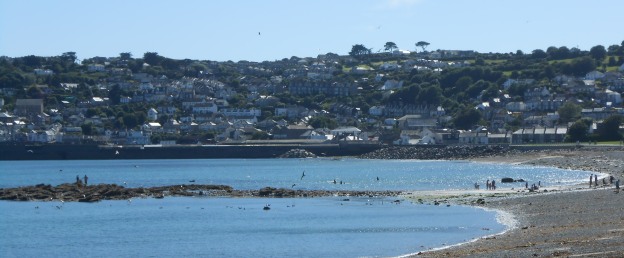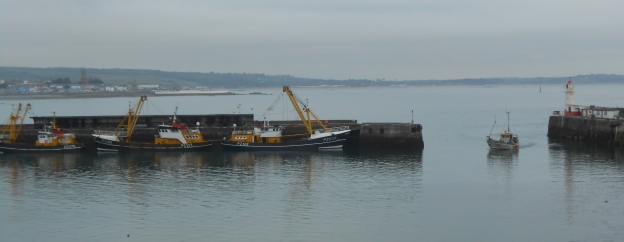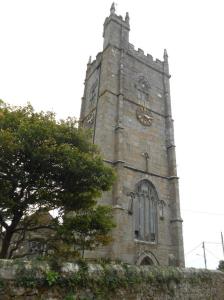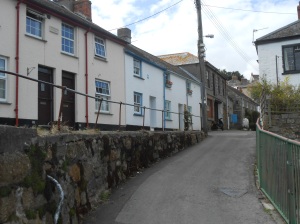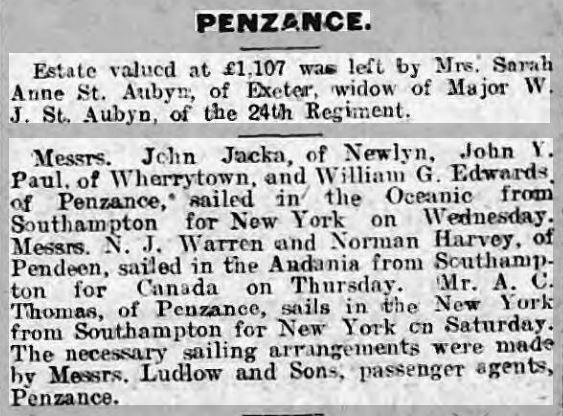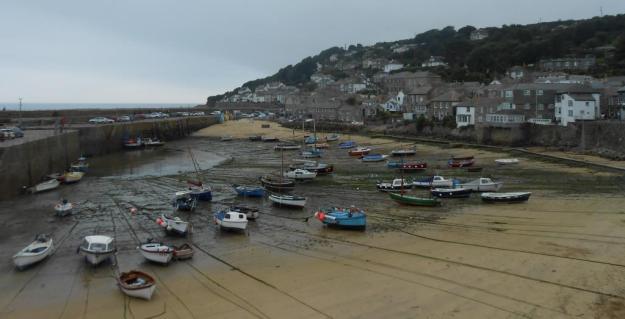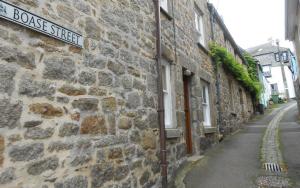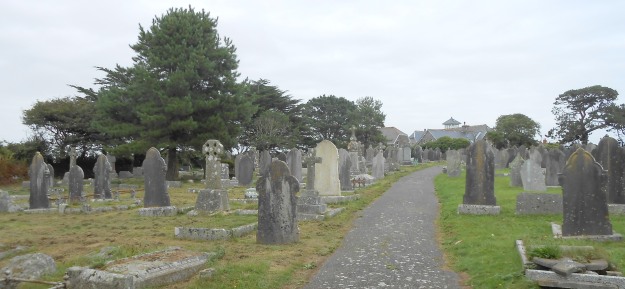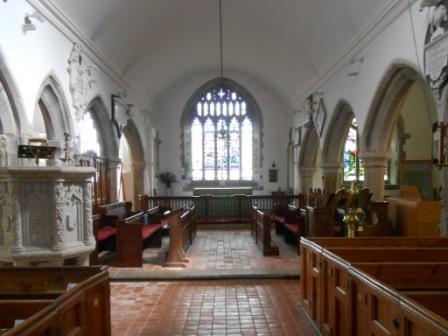My G-G-G-G Grandfather Benjamin Jacka arrived in the world on Thursday 1st November 1810. He grew up in tumultuous times, both literally with storms, hurricanes and food shortages, but also politically in the time of the regency and the Napoleonic wars.
Benjamin was the second of eight children of fisherman Peter Jacka and his wife Catherine Noell nee Kelynack and grew up in the Cornwall fishing village Newlyn. He was baptised at the age of 24 days in Paul Parish Church, up the hill above the village.
When he was 12 an event happened which eventually became enormously significant to the lives of Cornishmen for centuries: hundreds of miles away in Warwickshire William Webb-Ellis picked up a ball in a game of football and ran forward with it, inventing the game rugby, named after the town in which he lived. Allegedly[1][2].
Another sport popular locally was wrestling and in 1827 when he was 16 a top-name tournament was held by the Newlyn Road near Penzance with wrestling champions James Polkinghorne and Richard Saundry as umpires. “At twelve o’clock the sight was very imposing – some thousands of the most athletic young men that the world can produce (each of whom would have honoured Leonidas at the Straits of Thermopylae, Bonaparte in passing the Bridge of Lodi, or even Wellington himself in the battle of Waterloo), seated or standing in perfect silence and order, and with intense interest, to witness and participate in a sport for which their ancestors were so justly renowned.”[3]

Newlyn, Old Harbour, low tide
As boys Benjamin and brother Peter, who was 3 years older than him, and the other local boys would have spent a lot of time mucking about down by the harbour, swimming out to boats to help the men bring in the fish. Later brothers and sisters were Jane, Honor, William, Charles Kelynack, Matilda and Richard.
When Benjamin was 14 his brother Peter joined the Merchant Navy, and Benjamin did too, a few years later, c1838 when he was 18.
On Sunday 18 December 1831, aged 21, he was the first of his brothers and sisters to marry. His bride was Priscilla Tonkin, the fifth of nine children of Mousehole fisherman Philip Tonkin and his wife Anne Jasper [Mousehole was the next village]. Benjamin and Priscilla had their first child, Benjamin, in the spring of 1834. Sadly the baby died in infancy and was buried on 12 August up at Paul.
The following year, Benjamin was recorded[4] as working on the Lady Rowley, a “a 114 ton schooner built in the Port of Plymouth in 1833. It was mastered by ……. Captain Robert Horatio Harvey”[5] and possibly named after the wife of “Admiral Sir Charles Rowley GCB GCH (16 December 1770 – 10 October 1845) [who] was a Royal Navy officer who went on to be Commander-in-Chief, Portsmouth.” [6] On 19 April 1836 she was in Falmouth: “the Lady Rowley, together with from 10 to 12 Neapolitans, had arrived to load; the Lady Rowley was to come here for orders.”[7]

Paul Church
Benjamin and Priscilla’s daughter Susan was born in early 1837 and baptised on 14 May, and her sister Catherine [my ancestor] on was born on 27 April 1839 and baptised on 20 May 1840.
Benjamin was home with Priscilla and their daughters in the Street-An-Nowan [lower] area of Newlyn on the night of the 6 June 1841 census. They were living in Chapel Street, where they lived for the rest of their lives.
The birth of their second son, also called Benjamin, was registered in early 1842 and he was baptised on 10 April that year, and third son Nicholas was baptised on 11 May 1845.
A few weeks before that, on 23 April 1845, Benjamin had been up at Paul Church, witnessing the wedding of his sister Matilda to tailor John Ellis Nicholls.
Their sixth child and third daughter Priscilla was born c1848.
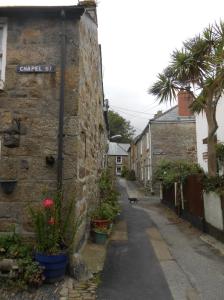
Looking up Orchard Place, Newlyn
On 30 March 1851, the night of the census Priscilla and her five children Susan, Catherine, Benjamin, Nicolas and Priscilla were home in Chapel Street but Benjamin, by then a master mariner, was likely away on ship as he wasn’t recorded at home.
In 1855 and 1856 Benjamin’s parents died: on 23 September 1855 his father Peter died of an effusion on the brain and on 20 October 1856 his mother Catherine died of dysentery, a long-term condition of hers.
On 20 April 1858 Benjamin was again a witness, this time when his eldest daughter Susan married fisherman John Hosken Tonkin. Susan and John went on to have four [known] children:
- Susan (1861);
- Elizabeth (c1865);
- John J (c1868); and
- Prissilla (1870, later Mitchell).
On 7 October 1859 Benjamin and Priscilla’s second daughter Catherine [my ancestor] married fisherman James Daniel Rowe and they had eight children together, including Benjamin Jaco Rowe [my ancestor].
On the night of the 1861 census Benjamin and Priscilla were home at 13 Chapel Street with their three youngest unmarried children Benjamin, Nicholas and Priscilla. Also in the house but recorded as a separate household were their daughter Catherine – now Catherine Rowe – and her baby Benjamin. Those three unmarried children had all married before the 1871 census.
On 13 May 1866 his carpenter son Benjamin married Caroline Polglaze. However he died before his wife; Caroline re-married in 1879. Her second husband was Thomas H Hobbs, a blacksmith late of the police force.
On 11 November 1867 their daughter Priscilla married mariner Andrew Williams. Together they had six children:
- Andrew (c1878, died young);
- Eliza (c1881);
- Nicholas (c1883);
- Ernest (c1885);
- Rhoda (c1888); and
- Andrew (1891, also died young).
By 1911 Priscilla was a widow (with Rhoda still living at home) and making ends meet by taking boarders.
Youngest son Nicholas became a Master Mariner like his father, and the 1871 census found them both on the Joseph Carne in Falmouth Harbour. Nicholas married Margaret Ann Williams in spring 1870 and together they had 9 children, many of whom were baptised as Methodists:
- Annie Margaret (c1871, School teacher, later James);
- Priscilla (1872, later Morris);
- Jane W (1875, school teacher, later Liddicoat);
- Mary Williams (1877 later Lugg, later Eddy);
- Zilpah (1878, learner of telegrapy, later Leggo, farmer’s wife);
- Elizabeth (1880, school teacher, later Davey);
- Nicholas (c1883, a schoolmaster);
- Elsie (c1885-1893); and
- Charles Williams (1888, a Post Office worker/postman).
Nicholas died in March 1915.
On 2 April 1871 Benjamin, by then 60, was away on the Joseph Carne in Falmouth with his son Nicholas among the crew. However three months later he was home. His wife of 40 years Priscilla was dying of cancer and she passed away on 29 July, aged 60. She was buried up in Paul Cemetery on 2 August 1871.

Paul Cemetery, Sheffield Road, Paul
Benjamin began fishing around this time. He lived on to the age of 81 but, fishing being a dangerous profession, had a couple of near misses.
On 13 October 1880 a destructive gale raged. “Among those which had succumbed to the storm were the Emily, owned by Mr Benjamin Jacko” in Newlyn Harbour”. The Cornishman paper noted that “Altogether the loss will amount to too large a sum, and those who were wise enough to insure in the Mount’s Bay Insurance Club (and we believe there are several) will now reap the benefit of their prudence”[8] – I don’t know whether Benjamin was prudent in that way or not. Possibly not as soon after that he was crewing for John Roberts on the Cyrus, although perhaps he had decided to just take a step back from owning his own boat.
On 23 November 1882 the Cornish Telegraph reported: “in September last” [1881 or 1882?] the lugger Cyrus sank in Mount’s Bay after being hit by the T.E.C. when pilchard fishing near Penlee Point – neither vessel was displaying lights despite it being thick and hazy with rain as this was customary when fishing in shallow waters. The T.E.C. struck the Cyrus which sank as soon as all the men had climbed aboard the T.E.C.. Benjamin had been aboard the Cyrus, the owner and master of which was John Roberts, and was a witness in the enquiry in November 1882. “Benjamin Jaco had held a certificate for thirty years, and had been master of a small vessel of 180 or 190 tons. He knew the rule of the road at sea. He had been fishing about ten years. He had never seen the red or green lights carried in a fishing boat. He had been in large open boats which never showed the red and green lights, but he had never been away from this locality.”
The ship had an experienced crew of four of whom “the eldest of the crew of the Cyrus on the occasion was over 70 and the youngest was 59” and had neither a boat in the vessel or side lights (no lantern with green and red slides) although “in the pilchard fishery it was not the custom to do so.” The Court found amongst specifics of complying/not complying with various Articles of the regulations that “Both the master of the Cyrus and the master of the T.E.C. are to blame for not carrying lights … but the Court finds that the immediate cause of the collision was the disregard by the master of the T.E.C. of the rule of the road at sea.” Both solicitors “intimated that their respective clients intended to comply with the law with regard to carrying red and green lights on their vessels.”[9]
In 1885 the foundation stone was laid for Newlyn’s new South Pier; the North Pier was built in 1888, hopefully both of these afforded more protection for future gales than for the 1880 gale which saw the loss of the Emily.
In the 3 April 1891 census Benjamin was recorded as a Retired Master Mariner and was living alone in Chapel Street. He died the following year, on 31 March 1892, and was buried on 3 April in Paul Cemetery.
Words and photos © Lynne Black
First published 8 May 2017 on https://starryblackness.wordpress.com/
[1] RugbyFootballHistory.com http://www.rugbyfootballhistory.com/webb-ellis.html accessed 9 April 2017
[2] The Rugby History Society, http://therugbyhistorysociety.co.uk/didhe.html , accessed 9 April 2017
[3] Morning Chronicle – Tuesday 02 October 1827, P3, BNA http://www.britishnewspaperarchive.co.uk/viewer/bl/0000082/18271002/014/0003
[4] FindMyPast’s Britain, merchant seamen records 1835-1857
[5] He [Martin Wright] was later the owner of a ship named the Lady Rowley a 114 ton schooner built in the Port of Plymouth in 1833. It was mastered by his future son-in law, Captain Robert Horatio HARVEY. http://www.genealogy.com/forum/surnames/topics/gartrell/264/ accessed 31 Dec 2016.
[6] https://en.wikipedia.org/wiki/Sir_Charles_Rowley,_1st_Baronet Accessed 31 Dec 2016
[7] BNA Maritime news, 22 April 1836 via FMP http://search.findmypast.co.uk/bna/viewarticle?id=bl%2f0001258%2f18360422%2f061
[8] Cornishman, 14 October 1880, P7, via BNA on FindMyPast: http://search.findmypast.co.uk/bna/viewarticle?id=bl%2f0000331%2f18801014%2f061
[9] The Cornish Telegraph 23 November 1882, P7, Col 1, via BNA on FindMyPast: http://search.findmypast.co.uk/bna/viewarticle?id=bl%2f0001617%2f18821123%2f132



